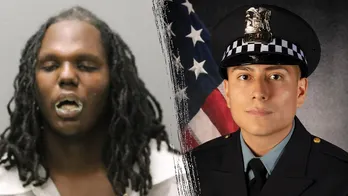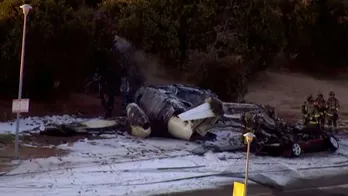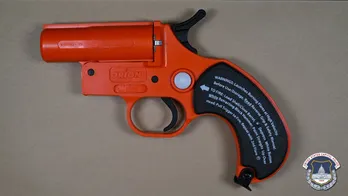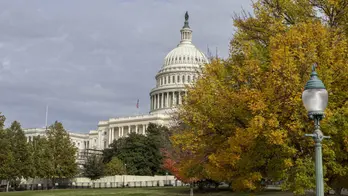Fake 'sober homes' targeting Native Americans scam millions from taxpayers
The heat is just breaking after a sweltering day in Phoenix. In a small patch of green amid the concrete, Madison Park, unhoused people are clustered in the scant shade of a few trees.
Along paths seeping heat, two women roll a cart, greeting people cheerfully as they offer cold water bottles, snacks and hygiene kits.
"You guys doing okay? Just trying to stay out of the heat?" ask Reva Stewart and Jeri Long, women from the Navajo Nation who live in Phoenix. Most of the people in the park are also Native.
As the women check in, they ask about places people have been staying, and Stewart takes notes.
"You mind if I record this?" she asks, pulling out a clipboard and noting down people's names, dates of birth and recent locations.
She does this because everyone here has stories about residential facilities and clinics which made promises about helping them with substance abuse problems, and all of them were disappointed.
"I wanted to get sober," says Wendell Smith. "And I wanted to get back on my feet again."
He was living on the White Mountain Apache Indian reservation, when some people offered to fly him to Phoenix to live in a sober home and get the services he wanted.
"They say that they can help me with a job and help me with this and that," he says. "I never seen none of it."
When he arrived, people were drinking in the home, and the classes, a mix of remote and in-person, seemed sketchy.
"It's like the same curriculum over and over again, most of us just ended up passing out in class," he says.
The people sitting with him, all of them Apache, chime in with stories of different homes. One place locked people in their rooms. Another gave residents money daily, which they spent on alcohol and drank in the home. House managers ignored residents who were violent or who took hard drugs. There were Native people from Montana, from New Mexico, from all over, who couldn't always remember how they got there and couldn't get home.
Smith himself ended up back on the streets and drinking.
"I'm actually thinking about getting back in the program again," he says. "But I want something that actually can help me."
He could get back into a facility any time. The people in the park say men cruise around at night, offering people a few dollars to come join their treatment center, or to bring them clients. But everyone is skeptical of what's on offer.
Slowly emerging stories
Across the street from this park is a store called Drumbeat Indian Arts. It has vivid murals of Native people and boards of posters of the disproportionate number of missing people from tribal lands out front.
Reva Stewart is the store manager, but in a back room she keeps supplies to help people on the streets (neatly labeled boxes of socks and energy bars sitting next to coolers of Gatorade), and runs an operation to track a proliferation of sober living and rehab facilities that she says do much more harm than good.
It started when she would look across the street to the Phoenix Indian Medical Center, and see white vans hanging around, their drivers talking to Native people at bus stops.
"I'm nosy," she says simply. So she asked someone.
"I said, can I ask you what that guy was asking you in that van...And he was like, 'yeah, he asked me if I needed a place to go, and he could give me a place to go.'"
Then last year, she says her cousin from the Navajo Nation in New Mexico was approached by a similar van.
She was struggling with alcohol, and the driver offered her a drink and a place to go. When she sobered up, she was in Phoenix, and when she managed to contact her family, Stewart picked her up and heard she had been taken to a place calling itself a sober home. Things fell into place.
"This is why there's white vans, this is what's going on," says Stewart. Since she was already active in trying to find missing people, people began to come to her with stories of these facilities.
Many were tragic. A former patient, Raquel Moody, who is Hopi and White Mountain Apache, now volunteers with Stewart with the activist group Stolen People, Stolen Benefits.
Moody's beloved cousin left the home they were in to get away from all the drinking there, and died homeless shortly afterward.
"Sobriety was one thing that he really, really wanted," she says. "He was a good guy. He was a funny guy, man...And what he wanted was just to be sober."
Stories of Native people being recruited into mysterious, substandard sober housing have been circulating for some time. Rowland Dash, a police officer on the Navajo Nation, works in Tuba City in Arizona and noticed something strange when he came to work on a Monday morning in November 2021.
"I noticed that nobody was arrested," he says. "So I figured, what's going on?" He clarifies that an average weekend sees around 15-20 arrests for public intoxication. So he went out on the streets, asked a few questions.
"And one guy says, you know what? Thursday last week, there was a white van that was parked at the strip mall," says Dash. "They were asking us if we wanted to go to a residential rehab facility down in Phoenix."
Dash contacted local detectives, and asked them to look into who was going down south. Often, the people in vans handed out business cards or contact information. He says Navajo police counted around 40 facilities that were recruiting on the reservation.
Then last year, the Navajo Nation's Attorney-General Ethel Branch says she started to hear about this issue during her campaign for office, but details were sparse.
"Very speculative, unclear, almost like a rumor," she says. And evidence was difficult to collect because the people involved are, "transient, they have mental health issues, they have substance abuse issues and are less and less likely to be easy to contact."
Which makes them a perfect population for bad actors to exploit, she says. Plus, even when people do come home, they are often reluctant to talk.
"People are embarrassed they ended up in that situation in the first place," she says. "They don't want to talk about how they ended up there."
But gradually tribal police and leaders, then Native politicians including state senator Theresa Hatathlie in Arizona, who is Navajo, began raising the alarm. Law enforcement including the FBI began investigating and eventually the scale of the problem, and its financial incentives, became clear.
Medicaid fraud on a grand scale
In May 2023, Arizona Governor Katie Hobbs led a press conference.
"Today, we are announcing actions against over 100 providers of behavioral health, residential and outpatient treatment services that we have credible reason to believe have defrauded the state's Medicaid program of hundreds of millions of dollars," she said.
She said residential homes and clinics billed the state Medicaid agency's American Indian Health Program for treatments that weren't adequately provided, while mostly Native people were housed in places that often weren't safe or sober.
"While we are still working to assess the scope of people affected, it may be in the thousands," she said.
So far, there have been 45 indictments in connection with the fraud by the Arizona Attorney-General's office, and more than 100 more facilities have been suspended. The FBI's investigation is ongoing, in tandem with state and tribal authorities. Arizona's Medicaid agency is conducting an audit and the amount of money that can be claimed per Native person treated has been reduced.
The state also launched a hotline for people to call if the home they were living in was closed, which connects people with help to get back to their home state.
But the accounts of current and former residents of the facilities suggest many are still operating, and the ripples of the fraud have spread to tribal lands across the country.
In Montana, the Blackfeet Nation declared a public health state of emergency, as did the Navajo Nation, which also launched Operation Rainbow Bridge, sending Navajo police to find tribal members in Phoenix and get them into legitimate facilities or bring them home.
"We made contact with several hundred on the streets," says Navajo police officer Arlinda Chischillie-Nez, of the May operation. "Young to even old. And, their preference is either alcohol or illicit drugs, and some meth use, and then we saw fentanyl." She and Sergeant Dash say they met people from Washington State, Wyoming and beyond.
She adds the impact on the reservation as a whole has been significant, and on her community of Dilkon, Arizona in particular.
"Not only my community, I do have one family member that went to a program and you got lost and eventually the person could come back to the community," she says. "Personally, I have been affected, you know,"
Attorney-General Branch says not everyone comes home safe.
"You hear really sad stories about relatives who go into these homes with an alcohol addiction, and then they come out with a different kind of an addiction," she says. "Or they just decease in the home based on other types of substance use."
Need for more legitimate help
People who were in the homes, plus officials and those who run legitimate facilities agree this scam would not have been so easy if there were more options for substance abuse treatment on tribal lands.
Stacy L. Martin, CEO of the Santa Fe Recovery Center, which runs the Four Corners Detox Recovery Center in Gallup, NM, on the edge of the Navajo Nation, says there is a dearth of help for addiction treatment in the area.
"When you couple the lack of access with the degree to which the need is in communities and particularly in New Mexico," she says, "you've got a recipe for disaster."
She adds the situation "only creates an incentive for players to try to figure out how to maneuver a marketplace to either create access or to gain access to a market that continues sadly to grow."
In a 2021 government survey, 29% of the Native population was found to need substance use treatment, higher than any other group. But only about 5% received any help
Navajo Nation President Buu Nygren says something has to change.
"It just really breaks my heart," he says. "And one of my goals is to open up facilities near or on Navajo that can help our own people."
He says he was recently in a meeting with other tribal leaders and asked about how many had a detox or rehabilitation facility on their land. No one raised a hand.
"And I said, we all gotta do what can we do to work together to build facilities that are geared toward helping our Indian people recover and heal."
Disclaimer: The copyright of this article belongs to the original author. Reposting this article is solely for the purpose of information dissemination and does not constitute any investment advice. If there is any infringement, please contact us immediately. We will make corrections or deletions as necessary. Thank you.







